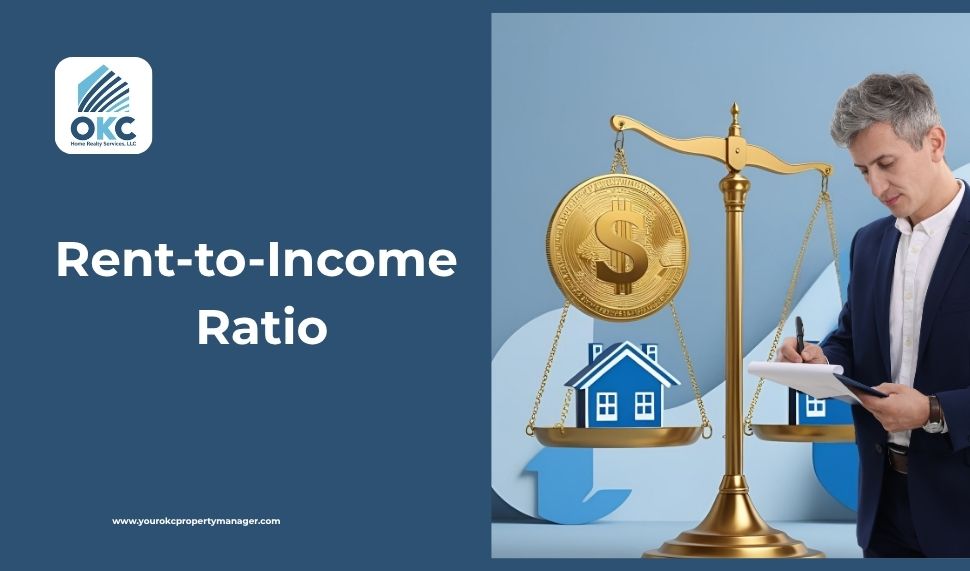You are about to calculate the rent-to-income ratio, right? As a landlord, making sure your rental property stays profitable and hassle-free starts long before the lease is signed. One of the best ways to do that is by selecting tenants who can reliably pay rent, and that’s where the rent-to-income ratio comes in. But how do you confidently select tenants who can reliably pay rent every month? The answer lies in understanding and applying the rent-to-income ratio, a simple yet powerful metric that can make or break your rental business.
As of 2023, 26% of U.S. renter households, representing about 12.1 million households, spent more than half of their income on housing costs, a record high that underscores the growing rental affordability crisis. By using the rent-to-income ratio, you can screen tenants more effectively, minimize risk, and maintain a steady cash flow. This approach not only protects your investment but also creates a fair and transparent rental process for all parties involved.
In this article, with my 15+ years of experience, I’ll provide everything you need to know about the rent-to-income ratio: what it is, how to calculate it, its pros and cons, and practical ways to use it to safeguard your rental property. Whether you’re a seasoned investor or just starting, this comprehensive resource will empower you to make smarter leasing decisions and maximize your rental income.
What is the rent-to-income ratio?
The rent-to-income ratio is a financial metric that compares a tenant’s gross income to the monthly rent they would be paying. In simple terms, it measures whether a prospective tenant can comfortably afford your rental property without putting too much strain on their finances.
Most industry experts and financial institutions recommend that tenants spend no more than 30% of their gross monthly income on rent. This “30% rule” is widely used as a benchmark for affordability, but as we’ll discuss later, it’s not the only way to assess a tenant’s financial health.
For landlords, the rent-to-income ratio serves as a quick, objective screening tool. It helps you filter out applicants who may struggle to pay rent on time, reducing the risk of late payments, non-payment, or costly evictions. By setting a clear income requirement, you also streamline your application process and ensure a more stable rental experience for everyone involved.
How to calculate the rent-to-income ratio?
Calculating the rent-to-income ratio is straightforward, but there are several methods you can use depending on your preferences and the specifics of your rental market. Let’s break down the most useful 3 common approaches:
1. Calculate gross income against a fixed rent percentage:
This is the best method and the one most landlords are familiar with. Here’s how it works:
- Step 1: Determine the tenant’s gross annual income.
- Step 2: Divide that number by 12 to get their gross monthly income.
- Step 3: Multiply the monthly income by your chosen percentage (which is usually considered 30%).
Formula:
(Gross annual income ÷ 12) × 0.3 = Maximum monthly rent
Example:
If a tenant earns $60,000 per year:
(60,000 ÷ 12) × 0.3 = $1,500
This means the tenant can afford up to $1,500 in monthly rent using the 30% rule.
2. Use a ratio multiplier:
Another popular approach is to use a ratio multiplier, often set at 3. This means the tenant’s gross monthly income should be at least three times the monthly rent.
Formula:
Monthly rent × 3 = Minimum monthly income required
Example:
If your property rents for $1,200 per month:
1,200 × 3 = $3,600
The tenant should earn at least $3,600 per month to qualify.
3. Alternative ways to calculate the rent-to-income ratio
In competitive urban markets, some landlords use the “40x rent rule,” where a tenant’s annual income should be at least 40 times the monthly rent. This method accounts for higher living expenses in pricier areas.
Formula:
Annual income ÷ 40 = Maximum monthly rent
Example:
If a tenant earns $80,000 per year:
80,000 ÷ 40 = $2,000
The tenant can afford $2,000 in monthly rent.
These alternative calculations provide flexibility and can be tailored to your local rental market or specific property needs.
Pros and Cons of Rent-to-Income Ratio
Understanding the pros and cons of the rent-to-income ratio can help you make smarter, more confident decisions when screening potential tenants. While this method is widely used and offers several benefits, it’s not without its limitations.
Let’s break it down so you can see how this tool fits into your overall tenant selection strategy.
Why is the rent-to-income ratio important?
Here are the pros of the rent-to-income ratio:
- Reduces Risk: Using a rent-to-income ratio helps landlords assess whether a prospective tenant can comfortably afford the rent. When renters have enough income to meet monthly obligations, it lowers the chances of late payments or rental defaults. In short, it’s a proactive way to reduce financial headaches down the line.
- Streamlines Screening: It creates a clear-cut, consistent standard that landlords can apply across the board. Instead of relying on gut feelings or subjective impressions, the rent-to-income ratio provides a measurable benchmark. This makes the tenant screening process more efficient, faster, and less prone to bias or inconsistency.
- Promotes Financial Stability: By encouraging tenants to live within their means, the rent-to-income ratio reduces the chances of someone becoming “rent-burdened”—a term used when over 30% of income goes toward housing costs. Tenants who are not financially stretched are more likely to stay long-term and take better care of the property, which is a win-win for everyone.
- Protects Your Investment: A steady stream of on-time rent payments is one of the key pillars of a successful rental property. When tenants meet a healthy rent-to-income ratio, there’s a much higher chance that your rental income remains consistent. This means fewer financial disruptions and a more predictable return on your investment.
Cons of the rent-to-income ratio
Here are the Disadvantages of the rent-to-income ratio:
- Doesn’t Account for All Expenses: While the general rule of thumb says rent should be no more than 30% of a tenant’s income, this doesn’t paint the whole picture. Many applicants have financial commitments like car loans, student debt, medical bills, or childcare expenses. A tenant might technically meet the ratio but still struggle to make ends meet once all their bills are factored in. So, to get a clearer picture of tenant’s financial reliability, landlords should also review their rental history.
- Ignores Creditworthiness: Income is just one part of the financial puzzle. Someone earning a high salary might still have a poor history of managing money, while another with a modest income might consistently pay bills on time. The rent-to-income ratio doesn’t tell you who’s financially responsible—it only shows how much they earn.
- Inflation and Market Fluctuations: In fast-growing markets like Oklahoma City, rent prices can outpace income growth. This means many otherwise qualified renters might get excluded simply because they don’t meet the traditional 30% threshold. Landlords who rely only on this metric could miss out on great tenants who would be reliable if given a chance.
- Potential for Discrimination: If applied too rigidly, the rent-to-income ratio can unintentionally disadvantage certain groups of people. It’s important to remember that fair housing laws prohibit discrimination based on race, gender, family status, or other protected categories. Focusing only on income without a broader financial picture could lead to biased decision-making, even if unintentional.
How can landlords protect themselves with a rent-to-income ratio?
Though having a rent-to-income ratio policy, landlords should take extra steps to protect their investments. For example, a tenant may appear to qualify on paper but have significant debts or unreliable income sources. You must always verify tenant’s income with supporting documents like recent pay stubs, tax returns, background checks, and bank statements. To protect yourself from the rent-to-income ratio, consider the following ways:
1. Require proof of income:
You have to ask tenants for recent pay stubs, tax returns, or bank statements to verify their income claims. Requesting multiple pay stubs (usually the last 2-3 months) and cross-checking these with bank statements and tax documents helps confirm the tenant’s actual earnings and reduces the risk of having the wrong information.
2. Run thorough background and credit checks:
These checks reveal financial red flags such as late payments, high debt levels, or bankruptcies that the rent-to-income ratio alone might miss. A solid credit history indicates a tenant’s likelihood to pay rent on time and manage financial obligations responsibly. For more information on credit checks, go through the article, How to Run Credit Checks on a Tenant.
3. Request a larger security deposit:
A higher security deposit provides a financial cushion in case of missed rent payments or property damage. This upfront protection can reduce your financial exposure and give you leverage if issues arise during tenancy.
4. Get a Lease Guarantor/Co-signer:
If a tenant’s financial situation is borderline, a co-signer with stronger income or credit can provide additional assurance. This person legally agrees to cover rent if the tenant defaults, lowering your risk.
5.Set up recurring rent payments:
Automated payments reduce the risk of late or missed rent by ensuring timely transfers each month. This system improves cash flow consistency and minimizes administrative follow-up.
6. Conduct regular property inspections:
Frequent inspections help identify maintenance issues early and ensure tenants are taking care of the property. This proactive approach can prevent costly repairs and maintain the value of your investment.
You May Also Read: Types of Rental Inspections
By combining the rent-to-income ratio with these best practices, you can significantly reduce your risk and ensure a smoother rental experience.
Alternatives to rent-to-income ratio
While the income-to-rent ratio is a popular screening tool, landlords can also consider these alternatives to assess a tenant’s financial reliability:
1. Debt to Income (DTI) Ratio:
The Debt to Income (DTI) Ratio compares a tenant’s monthly debt payments to their gross monthly income. By calculating DTI, you can see how much money they have left over after all their bills are paid. This gives you a more realisitc view of financial capablity of tenant to handle rent.
2. Credit Score:
A tenant’s credit score is a powerful indicator of their financial responsibility. It provides historical record of their borrowing and repayment habits, showing whether they pay their bills on time. A high credit score suggests a low-risk tenant who is more likely to meet their financial obligations, including your rent.
3. Employment Verification:
Employment Verification is crucial for ensuring a tenant has stable income source. A steady job history indicates tenants’s reliability. It suggests the tenant’s have a consistent income source to cover rent. However, you should not rely only on job status alone, even an unemployed applicant can afford rent if they have other financial planning or saving.
Conclusion on the rent-to-income ratio
The rent-to-income ratio is a time-tested tool that helps landlords screen tenants efficiently and fairly in today’s challenging real estate market. While it’s not a perfect measure since it doesn’t account for every financial factor, it remains one of the most reliable ways to assess a tenant’s ability to afford your property. By understanding how to calculate and apply this ratio, and by supplementing it with thorough screening and smart policies, you can protect your investment, reduce turnover, and foster positive landlord-tenant relationships.
At OKC Home Realty Services, we’re committed to helping landlords in Oklahoma City make informed decisions and maximize their rental returns. If you’re ready to smooth your tenant screening process or need guidance on setting the right rent-to-income ratio for your property, our team is here to help.
Frequently Asked Questions (FAQs)
What percentage of income should go to rent?
Most experts recommend that tenants spend no more than 30% of their gross monthly income on rent. This standard helps ensure that renters can comfortably afford housing without becoming financially overburdened.
What is a good rent-to-income ratio?
A good rent-to-income ratio is typically 3:1, meaning the tenant’s gross monthly income should be at least three times the rent. Alternatively, you can use the 30% rule or the 40x rent rule, depending on your market and preferences.
How do I calculate my rent-to-income ratio?
Divide the tenant’s gross monthly income by the monthly rent. If the result is 3 or higher, the tenant meets the common standard. For example, if the rent is $1,200 and the income is $3,600, the ratio is 3:1.
What are the minimum income requirements for renting an apartment?
Minimum income requirements vary by landlord and market, but most require tenants to earn at least three times the monthly rent in gross income. Some landlords may accept co-signers or additional deposits if a tenant falls slightly short.
How much should a tenant make to afford rent?
To afford rent comfortably, a tenant should make at least three times the monthly rent in gross income. For a $1,000 rental, this means earning at least $3,000 per month before taxes.

Author
Scott Nachatilo is an investor, property manager and owner of OKC Home Realty Services – one of the best property management companies in Oklahoma City. His mission is to help landlords and real estate investors to manage their property in Oklahoma.
 (
(









